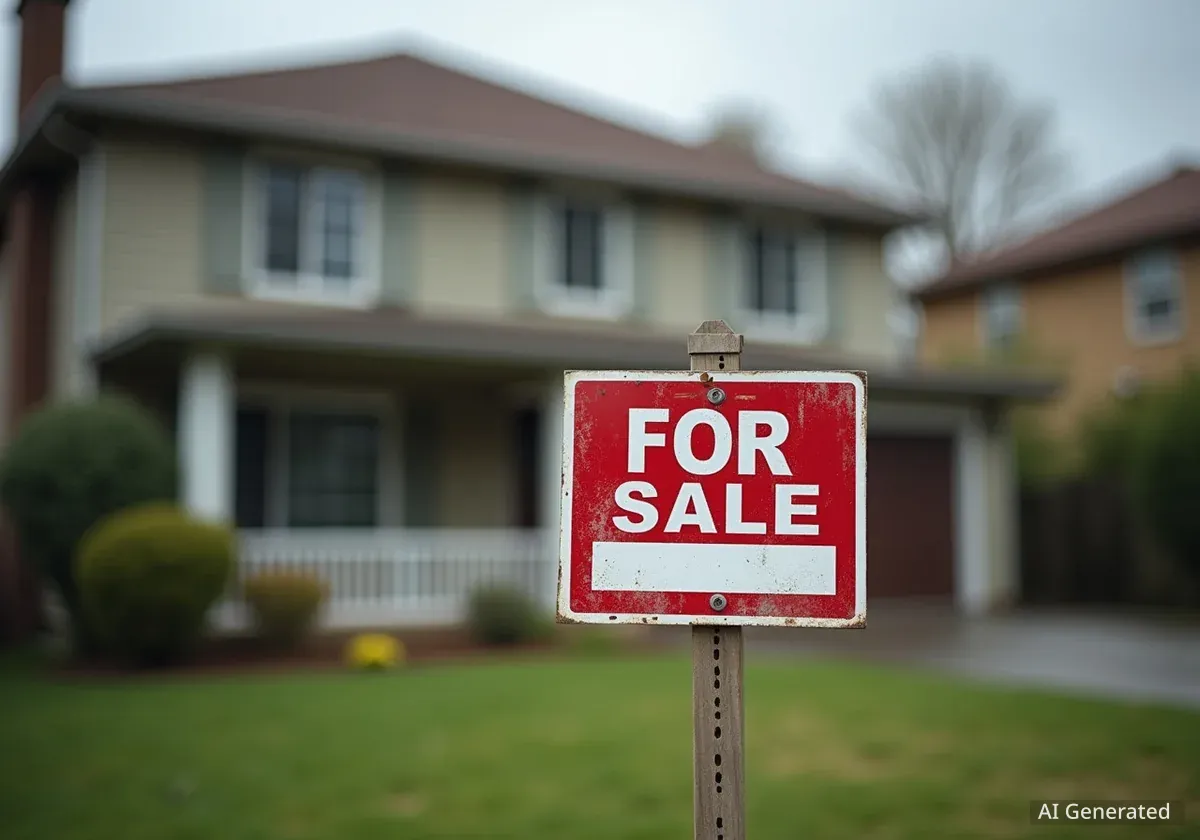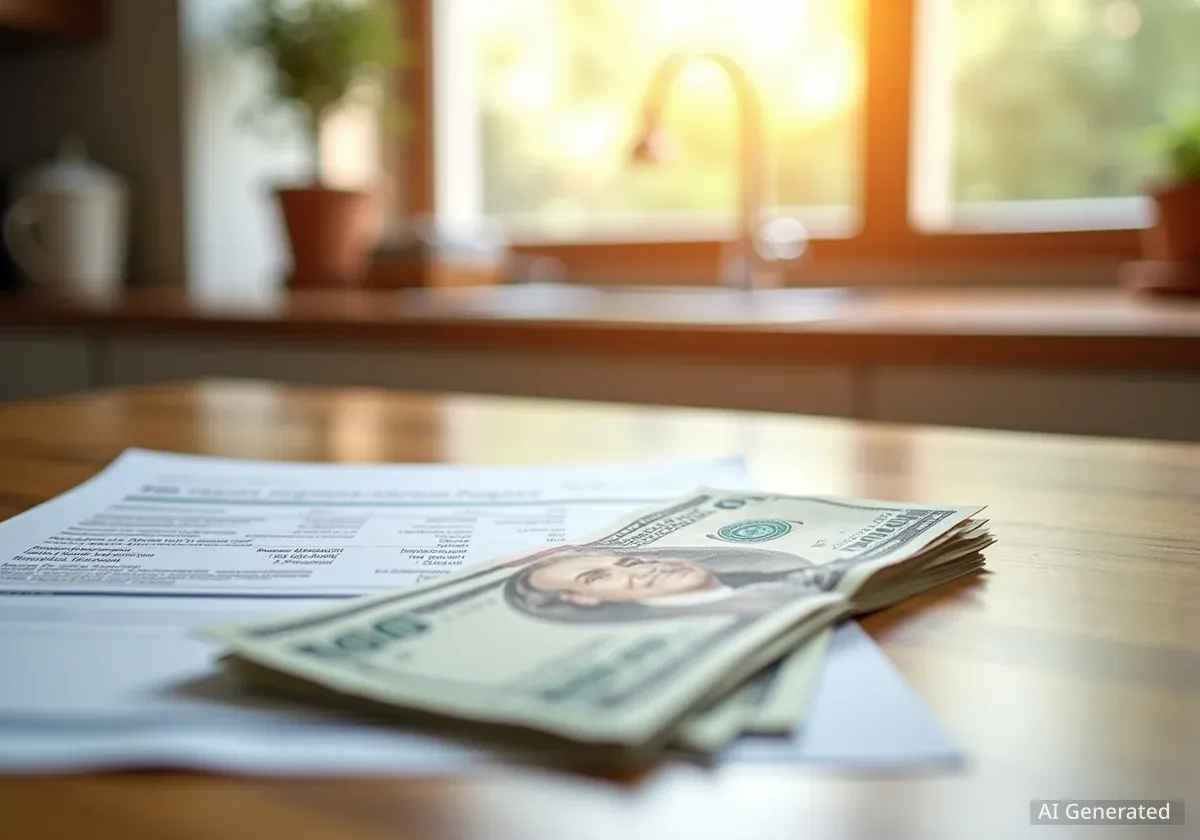The United States housing market is undergoing a significant transformation driven by the Federal Reserve's persistent efforts to control inflation. As interest rates have climbed, the cost of borrowing for a home has surged, leading to a sharp decline in housing affordability and a slowdown in sales activity across the country.
This shift has created a complex environment for both buyers and sellers. While potential homebuyers face the highest mortgage rates in over two decades, existing homeowners are hesitant to sell and give up their low-rate mortgages. This has resulted in a market characterized by low inventory, stubbornly high prices, and a growing gap between those who can afford to buy and those who are priced out.
Key Takeaways
- Mortgage rates have more than doubled since their historic lows, significantly increasing monthly payments for new homebuyers.
- Housing affordability has plummeted to its lowest level in nearly 40 years, sidelining many first-time buyers.
- Existing home sales have slowed considerably, but a persistent lack of inventory has prevented a major drop in home prices.
- The "lock-in effect" is a major factor, as current homeowners with low mortgage rates are reluctant to sell and move.
The Federal Reserve's Role in a Shifting Market
The primary driver behind the current housing market dynamics is the monetary policy set by the U.S. Federal Reserve. To combat post-pandemic inflation, the central bank has implemented a series of aggressive interest rate hikes, which have had a direct and powerful impact on the cost of home loans.
When the Federal Reserve raises its benchmark federal funds rate, it increases the cost for banks to borrow from each other. These higher costs are then passed on to consumers in the form of higher interest rates on various loan products, including mortgages, car loans, and credit cards.
How are mortgage rates determined? While influenced by the Fed's policy, the 30-year fixed mortgage rate is more directly tied to the yield on 10-year Treasury bonds. Investors' expectations about future inflation and Fed actions cause these yields to fluctuate, which in turn moves mortgage rates.
This policy has successfully pushed mortgage rates from historic lows of under 3% to levels exceeding 7% at various points. This rapid increase has fundamentally altered the financial calculations for millions of Americans hoping to purchase a home.
Impact on Monthly Payments
The most immediate consequence of higher rates is the dramatic increase in monthly mortgage payments. A small change in the interest rate can add hundreds of dollars to a borrower's monthly obligation, significantly reducing their purchasing power.
For example, a $400,000 home loan at a 3% interest rate carries a principal and interest payment of approximately $1,686 per month. At a 7% interest rate, that same loan's payment jumps to about $2,661 per month, an increase of nearly $1,000.
According to the National Association of Realtors, the typical monthly mortgage payment for a median-priced existing single-family home has increased by over 90% in the last three years due to the combination of higher rates and rising prices.
A Crisis of Housing Affordability
The surge in borrowing costs, combined with home prices that remain elevated from the pandemic-era boom, has created a severe affordability crisis. Many potential buyers, especially those entering the market for the first time, now find homeownership financially out of reach.
"We are witnessing a significant barrier to entry for a whole generation of buyers. The combination of high prices and high rates means that the income required to qualify for a mortgage on a typical home has skyrocketed." - Dr. Jessica Tanner, Housing Economist at the Urban Institute
Affordability indexes, which measure the relationship between median household income and the income needed to purchase a median-priced home, have fallen to levels not seen since the 1980s. This indicates that a smaller percentage of the population can afford to buy a home today than at almost any point in the last four decades.
The Challenge for First-Time Buyers
First-time homebuyers are disproportionately affected by this affordability crunch. They do not have existing home equity to use for a down payment, making it harder to overcome the initial financial hurdles.
They often compete for a limited supply of smaller, more affordable starter homes. However, even these properties have seen significant price appreciation, pushing them beyond the budget of many working families and young professionals.
The 'Lock-In Effect' and Stagnant Inventory
While demand has cooled due to high rates, the supply of homes for sale has also remained historically low. A primary reason for this is the "lock-in effect," a phenomenon where existing homeowners are unwilling to sell their properties.
Millions of Americans refinanced or purchased homes when mortgage rates were at record lows. A homeowner with a 30-year fixed-rate mortgage below 3.5% has a strong financial disincentive to sell their current home and buy a new one at a rate of 7% or higher.
What is the lock-in effect? It describes the situation where homeowners are reluctant to move because they would have to finance a new home at a much higher interest rate, leading to a significantly larger monthly payment even for a similarly priced property. This effect restricts the supply of existing homes on the market.
This reluctance to sell has kept housing inventory tight, which in turn has propped up home prices. Unlike previous housing downturns where prices fell sharply, the current market is seeing more of a slowdown in price growth rather than a widespread decline. In many competitive regional markets, prices have continued to inch upward despite the higher rates.
Regional Market Variations
The impact of rising interest rates is not uniform across the United States. Different regional markets are responding in unique ways based on local economic conditions, population growth, and existing housing supply.
- High-Cost Coastal Areas: Markets in California and the Northeast have seen more significant price corrections as high rates make already expensive homes even less affordable.
- Affordable Midwest and South: Some more affordable markets in the Midwest and South have shown more resilience, with continued buyer demand and stable price growth.
- Pandemic Boomtowns: Cities that saw explosive growth during the pandemic, such as Austin, Texas, and Boise, Idaho, have experienced notable cooling as the market normalizes.
These regional differences highlight the importance of local factors in shaping housing trends. While national policy sets the stage, the performance of individual markets depends heavily on their underlying economic fundamentals.
Outlook for the Future Housing Market
The future direction of the U.S. housing market remains closely tied to the Federal Reserve's decisions on interest rates and the broader inflationary environment. Most economists do not expect a return to the ultra-low rates of the past decade anytime soon.
Potential homebuyers may need to adjust their expectations, focusing on what they can comfortably afford in a higher-rate environment. For sellers, the market is no longer defined by the rapid bidding wars of 2021, requiring more patience and strategic pricing.
Ultimately, a sustainable housing market recovery will likely require a combination of factors: a moderation in interest rates, an increase in housing construction to alleviate supply shortages, and wage growth that keeps pace with home prices. Until then, the market is expected to continue its slow, challenging adjustment to a new financial reality.





